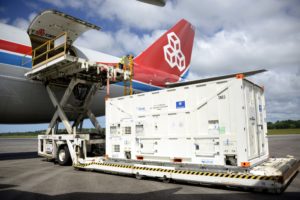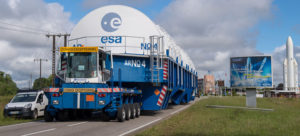Galileo satellites 25 and 26 have landed at Europe’s Spaceport in Kourou, French Guiana, joining their two predecessors ahead of their 25 July launch by Ariane 5.

One of the two Galileo satellites 25 and 26 being unloaded from their Boeing 747 cargo jet at Cayenne – Félix Eboué Airport in French Guiana on 1 June 2018. The satellites travel inside protective air-conditioned containers.
The pair left Luxembourg Airport on a Boeing 747 cargo jet on the morning of 1 June, arriving at Cayenne – Félix Eboué Airport in French Guiana that evening.
They were unloaded, still in their protective air-conditioned containers, to be driven by truck to the cleanroom environment of the S1A payload preparation facility at Europe’s Spaceport. Here they joined Galileo satellites 23 and 24, which arrived last month.
Launch vehicle
Launch vehicle elements for Arianespace’s third Ariane 5 flight at the service of Europe’s Galileo global satellite navigation system, which is planned for July, have been delivered to the Spaceport.

The cryogenic main stage for Arianespace’s Flight VA244 is transported across the Spaceport after arriving in French Guiana
These components, including the core cryogenic stage (known as the EPC – from its French title Etage Principal Cryogénique), arrived at French Guiana’s Port Pariacabo on 30 May aboard one of two sea-going roll-on/roll-off ships that transport launcher hardware from Europe to the South American launch site for Arianespace’s family of launch vehicles.
The mission – designated Flight VA244 in Arianespace’s launcher family numbering system – will orbit four more Galileo FOC (Full Operational Capability) spacecraft, to be deployed into medium Earth orbit at a targeted orbital altitude of 23 222 km. from a dispenser system on the Ariane 5 ES launcher version. Galileo is designed to provide a new European global satellite navigation system with precision positioning services under civilian control.
Galileo spacecraft are built by OHB System in Bremen, Germany, and the navigation payloads provided by Airbus-owned Surrey Satellite Technology in the United Kingdom. Flight VA244’s four passengers are located at the Spaceport, where they are undergoing their own pre-flight preparations.
Arianespace already has launched 22 Galileo spacecraft, with eight being orbited on two previous Ariane 5 missions (Flights VA233 and VA240 in November 2016 and December 2017, respectively), and the others lofted by seven medium-lift Soyuz vehicles carrying two satellites each. Ariane 5 is delivered to Arianespace by ArianeGroup as production prime contractor.
The Galileo System began Initial Services on 15 December 2016, and a growing number of commercial devices are using Galileo today. Completion of the constellation should improve Galileo’s positioning accuracy further still.
But Galileo satellites will continue to be launched into the future: a further 12 Galileo ‘Batch 3’ satellites were ordered last year, supplementing the 26 built so far to provide further in-orbit spares, and replacements for the oldest Galileo satellites, first launched in 2011.
